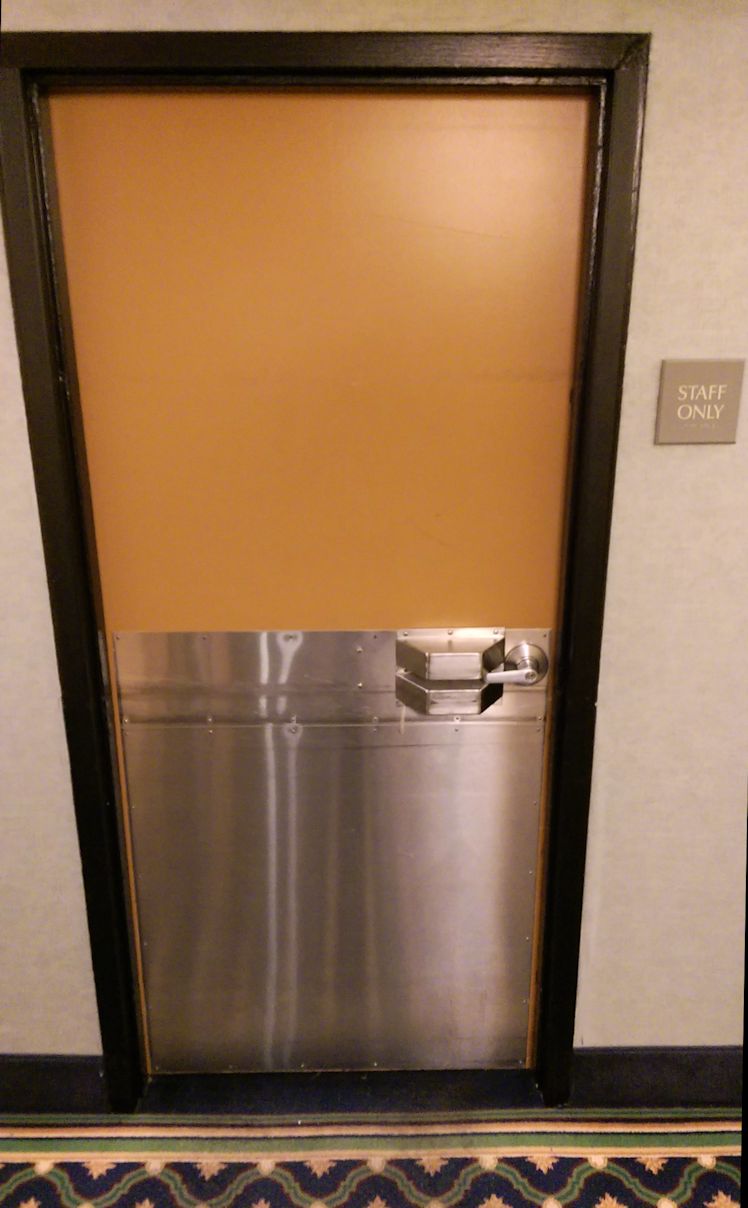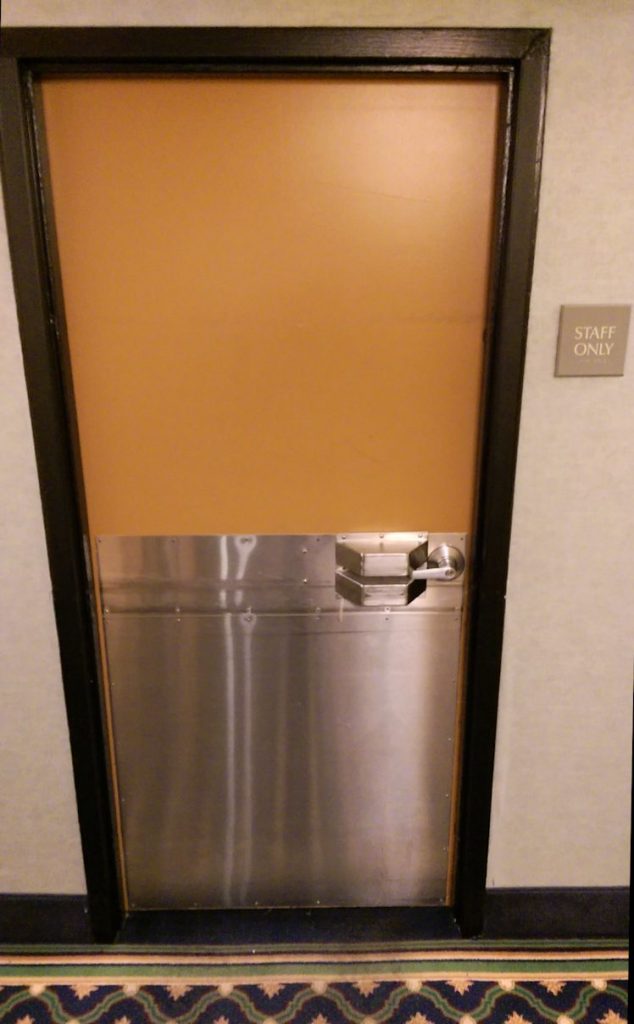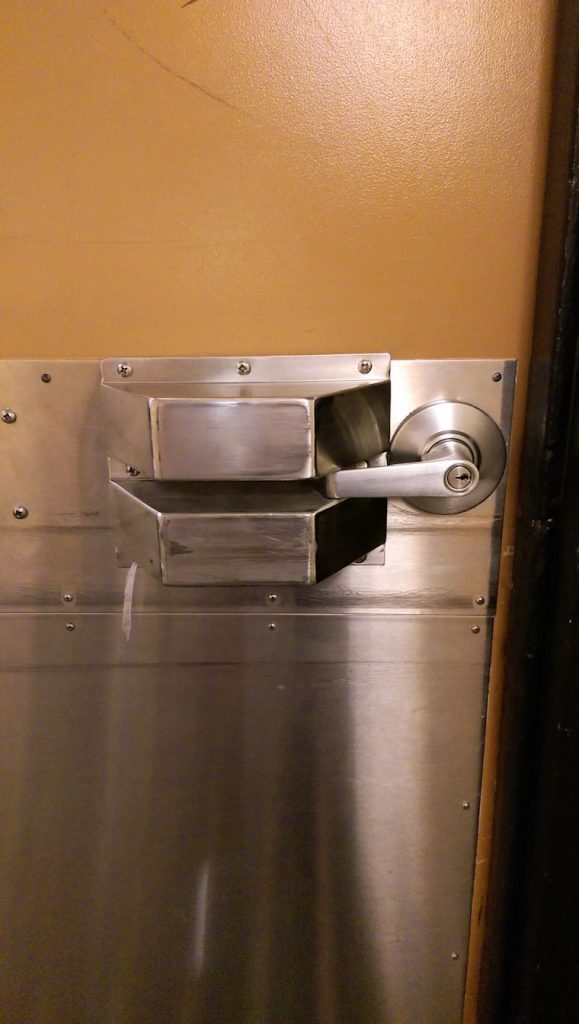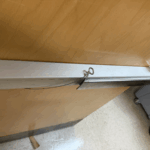David Toloday of Allegion sent me these photos and I had to ask – does the lever move? Was I seeing things? No – the lever does not move. Turn the key to retract the latch. I can’t say that I’ve seen this application before.
You need to login or register to bookmark/favorite this content.








So the purpose??
Isn’t there an easier way to do it??
I’m sure it was to protect the lever – they have probably had damage before from carts.
– Lori
yes, use a proper lock with ‘Store room function’
Would a L9080xLLL[less outside trim] and push plate be more effective? You would still have the core to retract the latch and push plate to have an area to push open.
That would accomplish the same thing without the need for the protector.
– Lori
Look closely you can see where the carts have hit the guard already. Must be a hospital, food service. 🙂 they are my worst department.
It’s a hotel, but I’ll be they have similar cart problems!
– Lori
I’ll bet it’s a labeled door!!
You’re probably right!
– Lori
If it is a labeled door, (and I agree that it probably is), the armor plate shouldn’t exceed 16″ tall, (unless labeled), not to mention that the additional kick plate adds an additional issue….. No?
Yes Tony – all of that stainless steel is an issue if it’s a fire door.
– Lori
New vandlgard feature!!
And needing to meet ADA requirements ??
Well, that’s a good question. The ADA doesn’t address keys, and there are millions of storeroom function locks installed, which operate the same way this lock does. It’s not operable from the outside without tight grasping/pinching/twisting, but since it’s a key that’s operating it, technically it’s not a violation. Here’s some more info on keys and the ADA: http://idighardware.com/2016/03/keys-and-the-ada/.
– Lori
Storeroom Operation:
1. Inside lever always unlocked for immediate egress – check
2. Outside lever always fixed – double check!
Those things are stainless steel. Can you imagine what they spent on those??? Almost any other option would have cost less and would have worked better.
It would have been less expensive to do it right! Fabrication, grinding, welding, stainless steel, labor costs to pay the welder, labor to install this machination…..$$$ Sheesh!
I’m surprised the frame is not knocked out of place. With the door being inswing the lever can only be sticking out into the hallway a scarce inch or two. I’m guessing they are protecting the frame from more damage as well.
Find a way, make a way…I guess.
There seem to be a number of different ways to handle this problem…no pun intended!
As already mentioned, use a mortise lock less lever trim. Another option might be to just mount the lever up higher on the door. Might look a little off, but it would be easier to handle and the cart wouldn’t hit the lever.
There doesn’t seem to be any indication that an electric strike is in use, but that, along with the mortise lock less lever, would be a good solution as well.
I dont see how it could be operated from the key side except maybe with a key (can rotating the cylinder retract the latch?). Not so cheap way to get a storeroom function.
Surely there are other doors in this hallway that don’t have the same “guard” – wonder what makes this one such a target?
Since we live in the retrofit world we see this kind of need on a regular basis. This is an aftermarket product from Keedex called a K12-S. Wholesale cost about $75.
Is often used to protect existing hardware including exit devices. http://www.keedex.com/main_pages/products/doorproducts/protectalok.html
Nice complementary goods to deal with abuse that happens in the field that engineers just can’t imagine
That’s one way to prevent lever droop.
it is amazing what people do to avoid the correct solution. It is so helpful that this forum exist so we can see the correct solution
Well, I guess that would make it a storeroom function then.
Sorry
More than likely laundry room or room cleaners room.
What do you call a male maid????
Hi Madam,
I am a quite new follower of your blog.
I have a doubt on lever handles. What is the different between solid and hollow lever handles with regards to ANSI standards and practical encounters. I basically need a comparison between above mentioned handle types.
Which is better and why?
Thanking you in advance. Will really appreciate your advise…
Regards,
Sajjath Samly
Hi Sajjath –
I don’t have anything official on this topic, but when I was specifying hardware I would typically use solid levers where I needed the durability, and hollow levers where cost was an issue and the application was less abusive.
– Lori